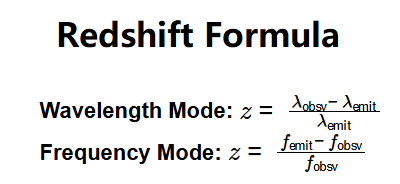1. What is Redshift Calculator?
Definition: This calculator computes the redshift parameter (\( z \)) of a star or galaxy, based on the emitted and observed wavelengths or frequencies of light.
Purpose: It is used in astronomy to measure the redshift of celestial objects, which indicates their velocity relative to the observer and provides insights into the expansion of the universe.
2. How Does the Calculator Work?
The calculator uses the following formulas:
Formulas:
- Wavelength Mode: \( z = \frac{\lambda_{\text{obsv}} - \lambda_{\text{emit}}}{\lambda_{\text{emit}}} \)
- Frequency Mode: \( z = \frac{f_{\text{emit}} - f_{\text{obsv}}}{f_{\text{obsv}}} \)
Where:
- \( z \): Redshift parameter (dimensionless)
- \( \lambda_{\text{emit}} \): Emitted wavelength (Å, nm, μm, mm, cm, m, km, in, ft, yd, mi)
- \( \lambda_{\text{obsv}} \): Observed wavelength (Å, nm, μm, mm, cm, m, km, in, ft, yd, mi)
- \( f_{\text{emit}} \): Emitted frequency (Hz, kHz, MHz, GHz)
- \( f_{\text{obsv}} \): Observed frequency (Hz, kHz, MHz, GHz)
Unit Conversions:
- Wavelength (\( \lambda \)):
- 1 Å = \( 10^{-10} \) m
- 1 nm = \( 10^{-9} \) m
- 1 μm = \( 10^{-6} \) m
- 1 mm = \( 10^{-3} \) m
- 1 cm = \( 10^{-2} \) m
- 1 m = 1 m
- 1 km = \( 10^{3} \) m
- 1 in = 0.0254 m
- 1 ft = 0.3048 m
- 1 yd = 0.9144 m
- 1 mi = 1609.344 m
- Frequency (\( f \)):
- 1 Hz = 1 Hz
- 1 kHz = \( 10^3 \) Hz
- 1 MHz = \( 10^6 \) Hz
- 1 GHz = \( 10^9 \) Hz
Steps:
- Select the calculation mode: wavelength or frequency.
- For Wavelength Mode:
- Enter the emitted wavelength (\( \lambda_{\text{emit}} \)) with its respective unit (Å, nm, μm, mm, cm, m, km, in, ft, yd, mi).
- Enter the observed wavelength (\( \lambda_{\text{obsv}} \)) with its respective unit (Å, nm, μm, mm, cm, m, km, in, ft, yd, mi).
- Convert both wavelengths to meters.
- Calculate \( z = \frac{\lambda_{\text{obsv}} - \lambda_{\text{emit}}}{\lambda_{\text{emit}}} \).
- For Frequency Mode:
- Enter the emitted frequency (\( f_{\text{emit}} \)) with its respective unit (Hz, kHz, MHz, GHz).
- Enter the observed frequency (\( f_{\text{obsv}} \)) with its respective unit (Hz, kHz, MHz, GHz).
- Convert both frequencies to Hz.
- Calculate \( z = \frac{f_{\text{emit}} - f_{\text{obsv}}}{f_{\text{obsv}}} \).
- Display the result, using scientific notation for values less than 0.001, otherwise with 4 decimal places.
3. Importance of Redshift Calculation
Calculating the redshift parameter is crucial for:
- Measuring Velocities: Redshift indicates the velocity of a star or galaxy relative to the observer, often due to the Doppler effect or cosmic expansion.
- Understanding Cosmic Expansion: Redshift measurements of distant galaxies provide evidence for the expansion of the universe, supporting the Big Bang theory.
- Distance Estimation: Redshift can be used to estimate distances to faraway objects, especially when combined with Hubble's Law.
4. Using the Calculator
Examples:
- Example 1: Calculate the redshift of a star where the emitted wavelength is 500 nm and the observed wavelength is 510 nm:
- Select Wavelength mode.
- Enter \( \lambda_{\text{emit}} = 500 \) nm.
- Enter \( \lambda_{\text{obsv}} = 510 \) nm.
- Convert to meters: \( \lambda_{\text{emit}} = 500 \times 10^{-9} = 5 \times 10^{-7} \) m, \( \lambda_{\text{obsv}} = 510 \times 10^{-9} = 5.1 \times 10^{-7} \) m.
- \( z = \frac{5.1 \times 10^{-7} - 5 \times 10^{-7}}{5 \times 10^{-7}} = 0.02 \)
- Result: \( z = 0.0200 \)
- Example 2: Calculate the redshift of a galaxy where the emitted frequency is 600 THz and the observed frequency is 580 THz:
- Select Frequency mode.
- Enter \( f_{\text{emit}} = 600 \) THz.
- Enter \( f_{\text{obsv}} = 580 \) THz.
- Convert to Hz: \( f_{\text{emit}} = 600 \times 10^{12} = 6 \times 10^{14} \) Hz, \( f_{\text{obsv}} = 580 \times 10^{12} = 5.8 \times 10^{14} \) Hz.
- \( z = \frac{6 \times 10^{14} - 5.8 \times 10^{14}}{5.8 \times 10^{14}} \approx 0.0345 \)
- Result: \( z = 0.0345 \)
5. Frequently Asked Questions (FAQ)
Q: What is redshift?
A: Redshift is the phenomenon where the wavelength of light from a star or galaxy increases (shifts to the red end of the spectrum) as it moves away from the observer, often due to the Doppler effect or cosmic expansion.
Q: What does a positive redshift mean?
A: A positive redshift (\( z > 0 \)) indicates that the object is moving away from the observer, as the observed wavelength is longer (or frequency is lower) than the emitted one.
Q: How is redshift related to the expansion of the universe?
A: Redshift of distant galaxies is a key piece of evidence for the expansion of the universe. The greater the redshift, the faster the galaxy is receding, supporting the Big Bang theory.
 Home
Home
 Back
Back
